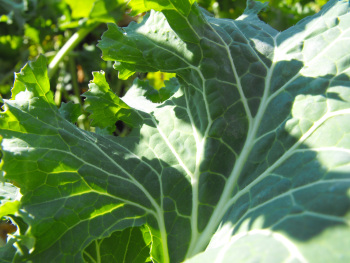
Planting for a Four Season Harvest, Part 11 (The End)
Winter-Harvesting
Crops
 Some few crops not only
survive, but can be harvested all winter. Parsnips taste sweeter
after
a frost, and I've dug up well-preserved carrots in March on the same
day I was planting peas, using them before the weather warmed up.
Egyptian or other perennial bunching onions are the only year-round
vegetable I know of in the North which can be used fresh almost every
day. In winter I use the lower white portions of the stalks ---
there
is not much green growth then --- chopping them into salads, or
flavoring meat dishes and soups. Leeks, so highly esteemed by
gourmets
for their delicate onion flavor, taste best when matured. Frozen
leeks
thaw out perfectly, and a full-grown specimen makes two
servings.
Some few crops not only
survive, but can be harvested all winter. Parsnips taste sweeter
after
a frost, and I've dug up well-preserved carrots in March on the same
day I was planting peas, using them before the weather warmed up.
Egyptian or other perennial bunching onions are the only year-round
vegetable I know of in the North which can be used fresh almost every
day. In winter I use the lower white portions of the stalks ---
there
is not much green growth then --- chopping them into salads, or
flavoring meat dishes and soups. Leeks, so highly esteemed by
gourmets
for their delicate onion flavor, taste best when matured. Frozen
leeks
thaw out perfectly, and a full-grown specimen makes two
servings.
With the possible exception
of carrots, all these hardy crops survive winter in the bare
ground.
But a mulch of hay or leaves keeps them better, and makes it easier to
dig them up. I don't put the mulch on over
the crops until the temperature holds steady in the low twenties.
I
then mark the rows with tall stakes because only the plume-like foliage
of the stately leeks is visible above a deep snow.
I prefer fresh vegetables
--- we all do --- harvesting something daily, picking or digging up
uncontaminated food, preparing and eating it the same day, sometimes
within the hour. With planning, such a year-round, 4-season
harvest is
possible --- even in a cold climate such as mine.
Tirrell, R. 1966, February. Planting for a 4-Season
Harvest. Organic Gardening and
Farming.
Reprinted by permission of Organic Gardening magazine. Copyright
Rodale, Inc., U.S.A. All rights reserved.
www.organicgardening.com.
Want more in-depth information? Browse through our books.
Or explore more posts by date or by subject.
About us: Anna Hess and Mark Hamilton spent over a decade living self-sufficiently in the mountains of Virginia before moving north to start over from scratch in the foothills of Ohio. They've experimented with permaculture, no-till gardening, trailersteading, home-based microbusinesses and much more, writing about their adventures in both blogs and books.
Want to be notified when new comments are posted on this page? Click on the RSS button after you add a comment to subscribe to the comment feed, or simply check the box beside "email replies to me" while writing your comment.
